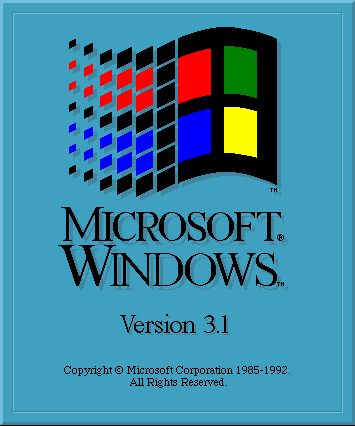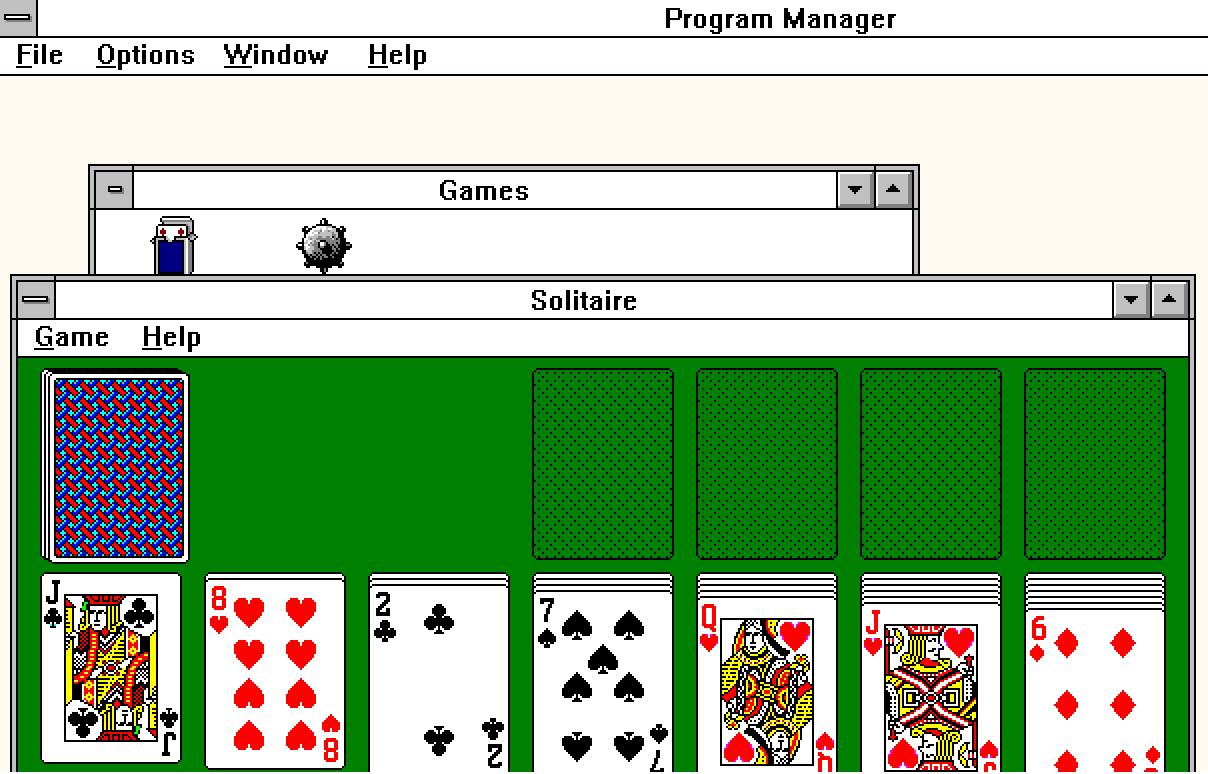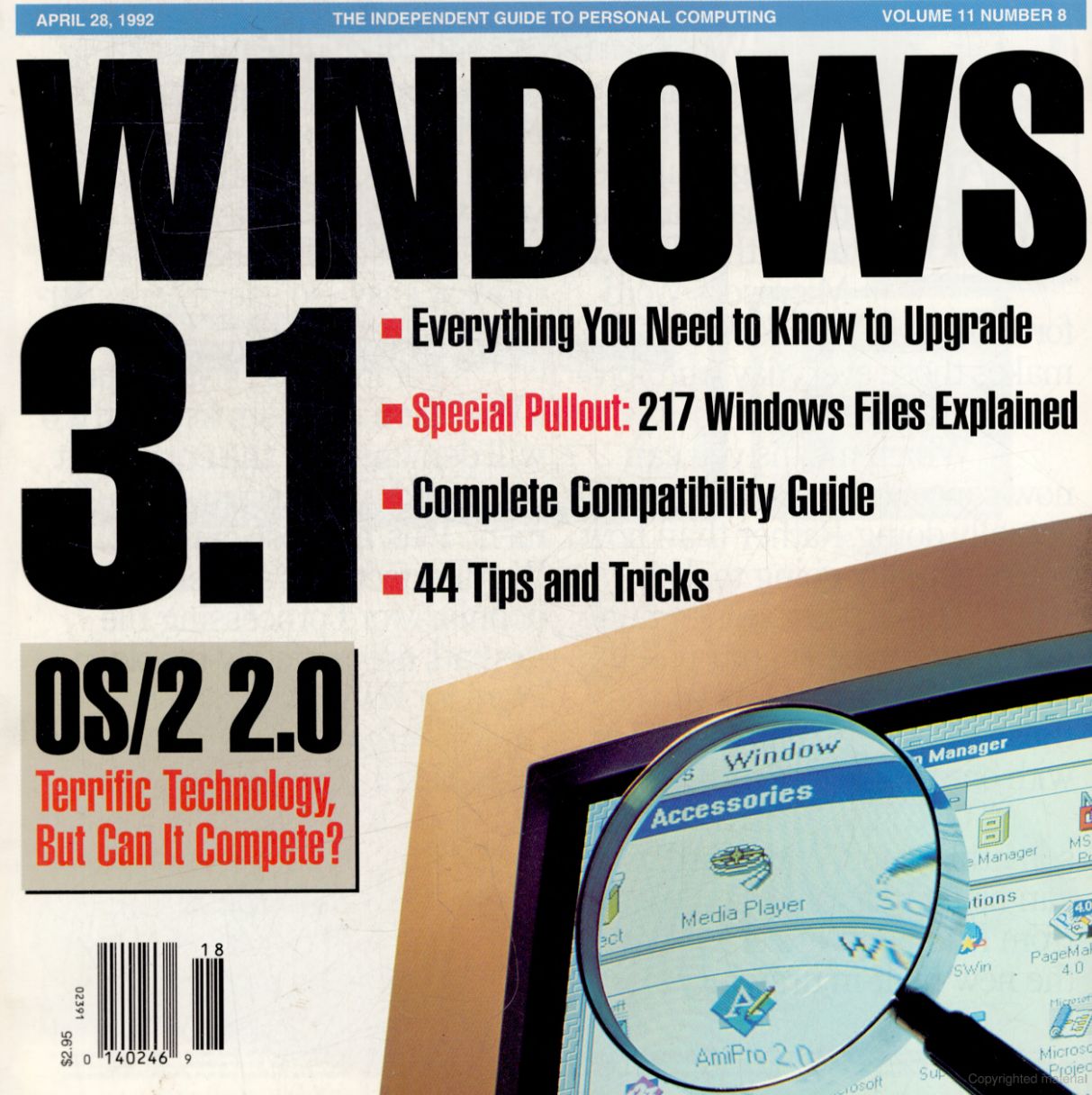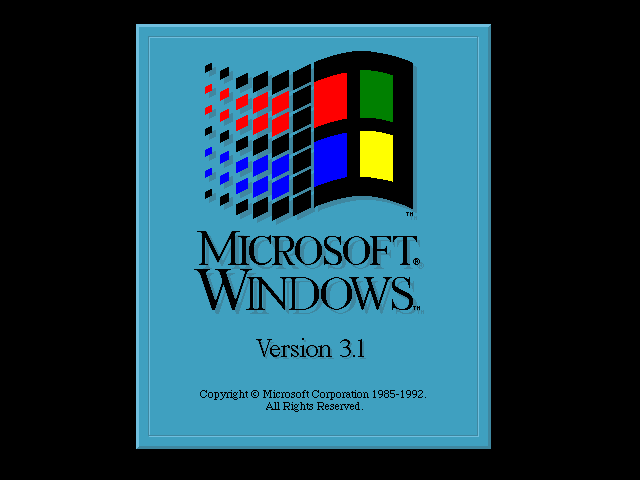
In my computer reality, Windows 3.x did not last long, only a couple of years, and was immediately forgotten after the advent of Windows 95. But even in the first half of the nineties it was never the main tool. Almost everything was done in DOS: games there, working with files there, texts there too, even the Internet (not yet the web, but only mail and news groups) worked through “console” utilities. How did it happen? Was the third version of Windows an optional app to the harsh text experience of a quarter century ago?
Having played enough with computers of twenty years ago, I began to research earlier systems, and I realized that with the exception of
dos games, they are for me a dark forest. Today is the first approach to the projectile, acquaintance with Windows 3.1, which is still not quite an operating system, rather a graphical shell on top of MS-DOS. Released in 1992, this version of Windows, still devoid of many interface elements that are obvious today, contained a large number of innovations, including the most valuable: Minesweeper.
I keep a diary of a collector of old pieces of iron in a Telegram . Until the end of the year, I plan to study some more moderately old phones, but not only. A large project to build a computer based on the 386th processor will soon begin.Windows, Mac, OS / 2 and all-all-all
The end of the eighties in the context of graphical user interfaces is a salad of different, poorly compatible platforms. We now know that everything was just beginning then, and at that time the software developers had to not only advance progress, but also deal with the harsh legacy that had accumulated over a decade. We can say that for Windows the concept of user interaction with a computer was finally defined only together with Windows 95, then there were mainly cosmetic and functional improvements. And what happened before that?
Something like that. No, if you look at the interface of the
Apple Macintosh , released in 1984, then the elements that are relevant for modern Mac OS X are already quite noticeable in it:
But Windows 1.0, released in 1985, is not like modern “windows” at all. Why is that? It seems to me that the point is Microsoft's lagging behind Apple, although both companies exchanged information and development (voluntarily and not so much), and had access to the early
developments of the Xerox PARC research center. But not only. "Mac" - it was still a computer of the highest price category, while Microsoft created mass solutions that work on mass hardware. And this hardware, to put it mildly, was not particularly suitable for the situation when the computer draws a beautiful interface, launches several programs at the same time, and at the same time does something useful.
The 80386 processor, Intel's first 32-bit processor, powerful enough to make the concept of a multitasking OS with a graphical shell really take off, was released in 1985, but in the next five years was, to put it mildly, not very accessible to the masses. Only in the beginning of the nineties everything turned out: both the experience of developing graphic shells, and the availability of iron. And this is not only a processor, but also a graphic system capable of displaying a picture of a sufficiently high resolution: first according to the VGA standard (640x480, 1987), and then SVGA (800x600, starting in 1988).
We add to this very superficial excursion into history the many difficulties with the organization of the computer business. This is Apple and Microsoft litigation over copyright on GUI elements. And Intel’s reluctance to transfer production of 386 processors to the side (as it was before), as a result of which (until 1991, when AMD began to produce clones) there were high prices. And the complex relationship between Microsoft and IBM, which were either going to loudly saw the “next-generation axis” together, were quietly getting divorced. Well, and IBM’s own attempts to return the open PC clone market back to the proprietary format, for which purpose incompatible system buses (MCA), keyboard and mouse connectors, and entire computers (PS / 2) were developed.
Launched in 1990, Windows 3.0 thus marked a change of eras: the creative search is over, money making has begun. The interface is brought to mind, there is support for the extended protected mode of 386 processors for full multitasking. At the same time, support was maintained for old systems, up to the early PCs and their clones with an 8086 processor, but real advantages were noticeable on 386s and 486s systems with a large (well, at least 4 megabytes) memory capacity. In 1992, an update to Windows 3.1 was released, and the latest release (3.11) was released in November 1993. This is where the story of 16-bit Windows ends: in the same 1993, 32-bit Windows NT was released, and two years later, the "popular" Windows 95.
When your computer is too fast
For experiments, I opted for Windows 3.1: despite a slight change in version number, it was a big update of the original 3.0. Support for older systems on Intel 8086 was discontinued, support for TrueType fonts appeared, the limit of 16 megabytes of RAM was removed, which is important for my test computer.
This is the ThinkPad 600, the most low-power computer in this series, from those that I have in my collection. Last year I
talked in detail
about how I installed MS-DOS on it, but Windows 3.1 then installed crookedly and was practically never used. It's time to fix this omission, but wait, it's the same 1998 computer. With a Pentium II 233 MHz processor. Isn't it a bit much?
Too much, but this computer officially supports Windows 3.1, there are drivers for hardware. I also have slightly less powerful laptops (with Pentium MMX processors), but there isn’t much difference: for Windows 3.1, this is in any case too much. As of 1992, Intel 80486 processors with a frequency of 50 or 66 megahertz were installed in the top computers. But the 386th and the 286th were still too early to write off. Fortunately, there is a way to slow my laptop too fast to the right performance.
This video is from the extremely useful Australian channel Phil's Computer Lab. In terms of entertainment, the channel is possible and inferior to the products of other YouTube, but Phil provides a lot of useful information for colleagues - collectors of old iron. The video above shows how you can reduce processor performance using the
Setmul utility - a modern (developed since 2014 by enthusiasts) utility for DOS. It is able to lower the frequency of some processors Intel, VIA and AMD. In my case, this did not work, but another method worked.
Phil’s video contains “reference” performance indicators for various systems in the old 3DBench benchmark. Initially, I got a result of 160 points, but after disabling the first level cache using the setmul utility, processor performance dropped almost exactly 16 times. The final result of 10.3 points perfectly matches the 80386 processor with a frequency of 25 megahertz. Of course, this is still not a completely honest deceleration: the ThinkPad 600 has too much memory in any case (32 megabytes are soldered on the board, I removed additional modules), and a Compact Flash card is installed instead of the hard drive. But it’s suitable for experiments. In addition, I replaced the built-in optical drive with a three-inch drive.
Floppy zen
The fact is that Windows 3.1 never came on CD-ROMs (UPD, sometimes it did, see
mistergrim's comment ): you had a choice between six three-inch floppy disks and seven five-inch floppy disks. Now you can install Windows from another medium, and simply copy the necessary files, but the installation from floppy disks is correct and corresponding to the era. The source of distributions has traditionally been the archive on the
WinWorldPC website, but there it is the original disk images for Win3.1 that are available only for the English version. This is not very good: unlike modern OSs, adding Russian language support after installation just doesn’t work.
Installation takes 8 minutes or a little more than ten in the "emulation" mode of the 386th, as in the video. Installation time is clearly limited by the speed of reading data from a floppy disk. After installation, it’s worth adding the drivers for the video card and sound card of my laptop (for IBM laptops you can get them
here ), and you can get started. Although not: crack required. In search of such, I came across a
book by Alexander and Grigory Frolov, in which Stipler’s CyrWin crack is mentioned. And then a
distribution was found.
And that’s what happened. In Windows 3.x logic, the “Program Manager” is a key element of the graphical shell, the desktop, or the ancestor of the “Start” button in a separate window, closing it leads to a return to MS-DOS. The window control buttons are more likely to resemble those of the Macintosh: on the right you can minimize and maximize the window, with the left button you open the context menu from which the window can be closed. The usual right-click menu does not yet exist. Together with Windows comes a decent set of programs with many familiar names: Notepad, Paintbrush, Calculator. Due to the lack of a taskbar, the clock is a separate application. Minimized but working programs are placed on the desktop.

In Windows 3.1, Minesweeper first appears, the standard resident of all Windows right up to the “seventh,” and the joy of office workers over the past 27 years. Solitaire Solitaire came to Windows a little earlier - in 1992, along with the original release of Windows 3.0. And if there is a Minesweeper, then you can live! Yes, but not really.
The built-in file manager supports the newfangled Drag and Drop, but does not support copying more than one file through the clipboard! If you need to transfer several files at once, you will have to enter the path in a separate window, and there is not even the option to select a folder in the interface. Even in the early nineties, the file manager did not respond very well, but by modern standards it is darkness and horror. Fortunately, there is Total Commander:
Folk panel file manager is available on
the developer's
site . Support for 16-bit systems stopped at version 6.58, while the current 9.22 works on all OSs starting with Windows 95 / NT. Total Commander installed and worked without any problems, and even recognized my own license key.
But the attempt to install Microsoft Word ended in failure. I chose version 2.0 corresponding to the release time of Windows 3.0 and 3.1 (1991). Firstly, during installation, there were problems with crack, and after launch, problems with fonts. The Second Word has problems working with TrueType fonts, and in this case does not comply with the WYSIWYG principle: when printing, you will not get exactly what you see on the screen. It is necessary to install the classic sixth version of the Word: it was released in 1993 (this is the next release after 2.0, the
numbers 3.4 and 5 were skipped by UPD: these versions of the word exist, only under DOS), supports TrueType and generally provides everything you need for the basic work with text. Word 6.0 was so cool that many used it before the 2000s.
Impressions
In April 1992, PC Magazine made Windows 3.1 the
theme of the issue . It’s already clear from the cover that it will be more promising: the 32-bit OS / 2 2.0, released in the same year, technically much more advanced, turned out to be on the sidelines, and its review mainly discusses whether it is convenient to run Windows applications on it. In 1992, Windows also released software previously available only on Apple computers, in particular, Adobe Photoshop version 2.5.

PC Magazine not only discusses all the changes in detail, they also provide a complete list of distribution files with descriptions (they would try to do this for Windows 10). The review provides interesting facts: thanks to an improved caching system for reading and writing to the hard drive, in some scenarios, productivity increases significantly. Now it will be difficult to find an example of software, the update of which gives the same advantages, rather the opposite. Windows 3.1 significantly improves stability and provides more information to developers to search for bugs. This is especially true of running DOS-programs from Windows, which before that often led to an uninformative error Unrecoverable Application Error.
In Windows 3.1, Object Linking and Embedding technology became standard, it became possible to insert tables from Excel to Word, or audio recordings from the built-in recorder application into the Write text editor. Assuming that for many readers, Windows 3.1 will be the first graphical shell, PC Magazine provides five reasons to buy. This is the creation of documents with high-quality fonts and complex graphics. Running multiple applications at once. Interaction of applications with each other through DDE and OLE technologies. Clear interest in Windows from software developers. And finally, “if you don’t like Windows, it’s easy to remove, or just ignore it.”

That is why Windows 3.x is the perfect complement to a retro DOS system. It works on the classic high-grade DOS up to version 6.22, and can be turned off at any time, with the return to text mode without any reboot. However, in the "production" I still put the latest version of Windows 3.11 for Workgroups with full 32-bit disk subsystem and normal network support. Windows 95 is more convenient, but for 386 systems it is already heavy, computers based on 80486 or Pentium processors are more suitable for it. In 1995, when I got my first own PC-compatible computer, it was on the 386 processor. Despite everything, I used Windows 95. It was terribly slow, but then the choice was obvious: the more modern, the better. In 2019, the debate on Windows 3.x vs 95 is unlikely to make sense, but from a re-introduction to Win3.1, I realized that not everything is so bad. This is a suitable OS (or shell, as you like) if you want to build a retrocomputer with strict adherence to the time frame.

This is what I will do in the near future.